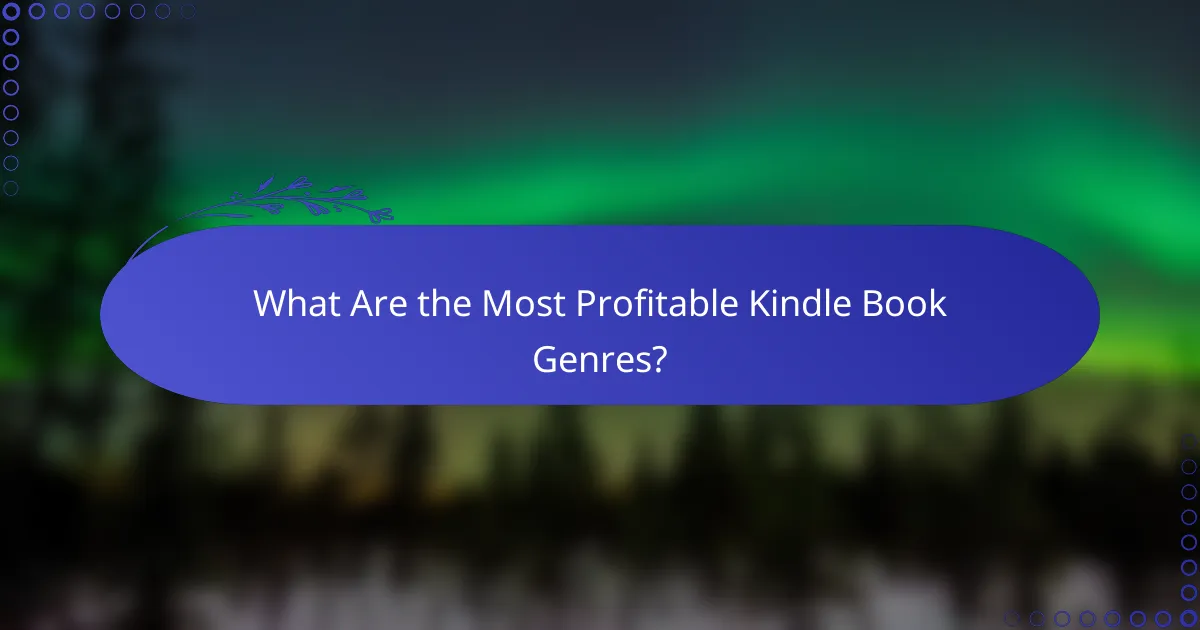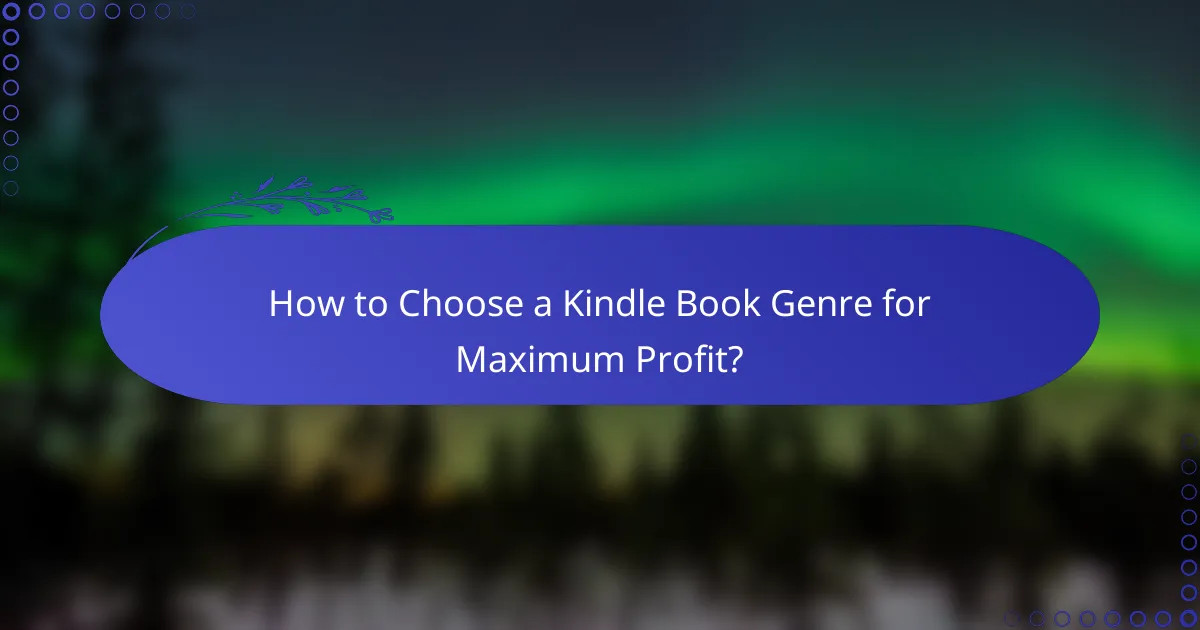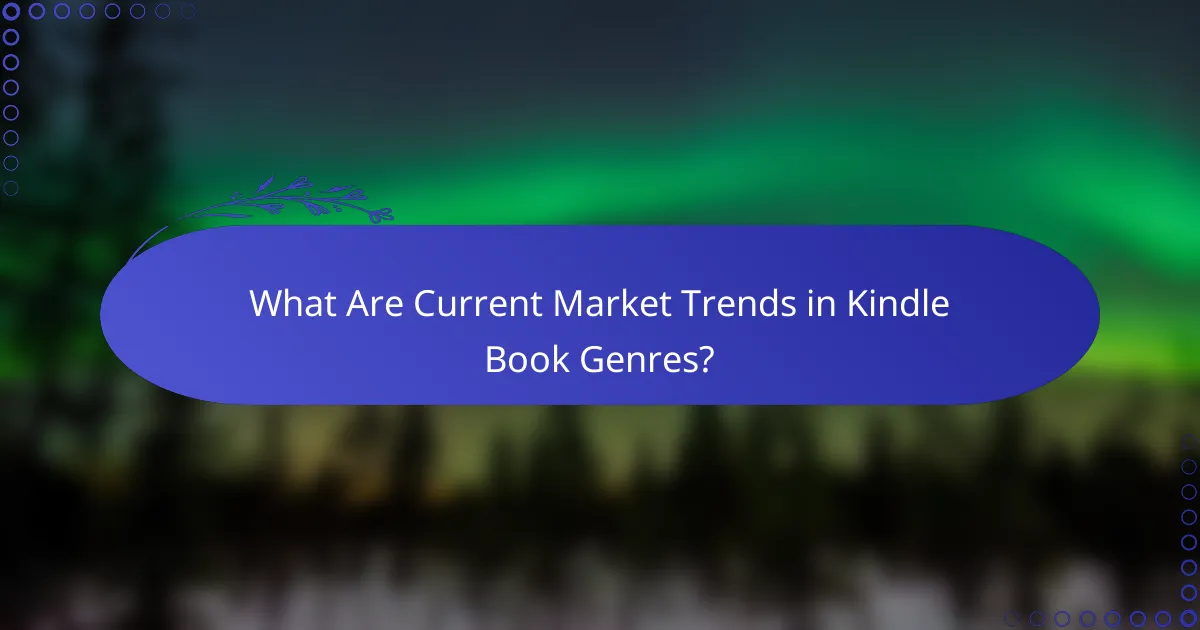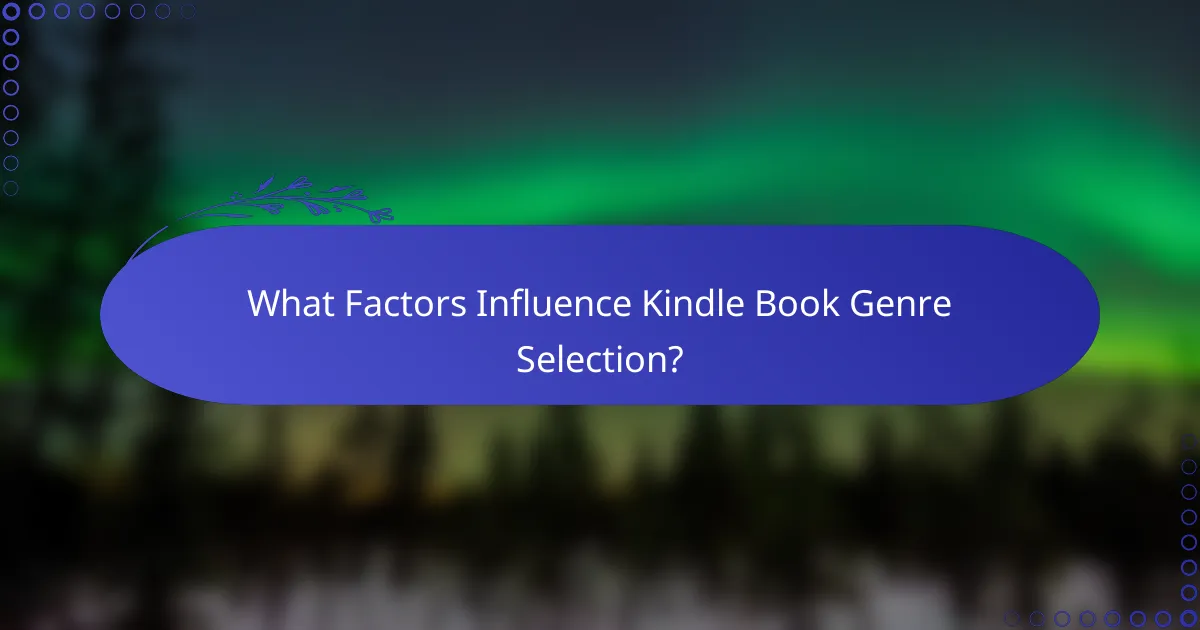Choosing the right Kindle book genre is crucial for maximizing profitability and reaching a broad audience. By analyzing current market trends and understanding reader preferences, authors can identify lucrative niches such as Romance, Thriller, and Science Fiction. Staying attuned to shifts in consumer behavior, including the rise of audiobooks and serialized fiction, can further enhance a writer’s success in the competitive landscape of self-publishing.

What Are the Most Profitable Kindle Book Genres?
The most profitable Kindle book genres typically include Romance, Thriller, Science Fiction, Self-Help, and Fantasy. These genres attract large audiences and often yield higher sales due to their popularity and reader engagement.
Romance
Romance is one of the leading genres in the Kindle marketplace, appealing to a diverse audience. Subgenres like contemporary, historical, and paranormal romance can significantly boost sales, with many readers seeking new titles regularly.
To maximize profitability in this genre, consider writing series or standalone novels that feature strong character development and emotional arcs. Engaging cover designs and compelling blurbs can also enhance visibility and attract potential readers.
Thriller
The Thriller genre captivates readers with suspenseful plots and unexpected twists, making it highly profitable. This genre often includes subcategories such as psychological thrillers, crime thrillers, and action thrillers, each with its own audience.
Writers should focus on creating gripping openings and maintaining a fast-paced narrative to keep readers engaged. Utilizing cliffhangers at the end of chapters can encourage readers to continue to the next book, increasing overall sales.
Science Fiction
Science Fiction offers a vast landscape for creativity and innovation, attracting readers who enjoy speculative concepts and futuristic settings. This genre can encompass subgenres like space opera, dystopian fiction, and cyberpunk, each appealing to different niches.
To succeed in Science Fiction, authors should develop unique worlds and thought-provoking themes. Engaging with reader communities and participating in genre-specific promotions can also enhance visibility and sales potential.
Self-Help
Self-Help books are increasingly popular, as readers seek guidance on personal development, health, and productivity. This genre often features practical advice, actionable steps, and motivational content, making it appealing to a broad audience.
When writing Self-Help books, focus on providing clear, concise information and relatable anecdotes. Building an author platform through social media and workshops can help establish credibility and attract a loyal readership.
Fantasy
Fantasy remains a beloved genre, characterized by imaginative worlds, magical elements, and epic quests. Subgenres like urban fantasy, high fantasy, and dark fantasy cater to various reader preferences, contributing to its profitability.
To thrive in Fantasy, authors should create immersive worlds and well-developed characters. Engaging with fan communities and leveraging book series can help sustain interest and drive sales over time.

How to Choose a Kindle Book Genre for Maximum Profit?
To choose a Kindle book genre that maximizes profit, focus on current market trends, audience preferences, and competition analysis. This strategic approach helps identify lucrative niches and aligns your writing with reader demand.
Analyze Market Trends
Start by researching popular genres on platforms like Amazon Kindle. Look for trends in sales rankings, customer reviews, and seasonal spikes in specific genres. Genres such as romance, mystery, and self-help often show consistent demand, but emerging trends can offer new opportunities.
Utilize tools like Google Trends or Kindle Spy to track genre popularity over time. This data can help you spot rising genres or declining ones, allowing you to make informed decisions about where to focus your writing efforts.
Understand Audience Preferences
Understanding what readers want is crucial for selecting a profitable genre. Engage with your target audience through social media, forums, or reader surveys to gather insights on their preferences. Pay attention to the themes, styles, and formats that resonate most with them.
Consider demographic factors such as age, gender, and reading habits. For instance, younger audiences may prefer genres like young adult fantasy, while older readers might gravitate towards historical fiction or memoirs. Tailor your genre choice to align with these insights for better market fit.
Evaluate Competition
Assess the level of competition within your chosen genre. High competition can indicate a profitable market, but it also means you need to differentiate your book. Analyze bestselling titles to understand their strengths and weaknesses, and identify gaps that your book could fill.
Use tools like KDP Rocket or Publisher Rocket to evaluate competition metrics such as average sales, number of reviews, and pricing strategies. Aim for a balance where the genre has enough demand but not so much competition that your book gets lost among others.

What Are Current Market Trends in Kindle Book Genres?
Current market trends in Kindle book genres indicate a significant shift towards audiobooks, indie publishing, and serialized fiction. These trends reflect changing consumer preferences and technological advancements that shape how readers engage with content.
Rise of Audiobooks
The rise of audiobooks has transformed the publishing landscape, with many readers opting for audio formats due to their convenience. Audiobooks allow multitasking, catering to busy lifestyles, and have seen a surge in popularity, particularly among younger audiences.
Platforms like Audible and Kindle’s own audiobook offerings have made it easier for authors to reach listeners. Consider integrating audiobooks into your publishing strategy, as they can enhance your reach and profitability.
Growth of Indie Publishing
Indie publishing has experienced remarkable growth, empowering authors to bypass traditional publishing routes. This trend allows for greater creative control and higher royalty rates, often ranging from 35% to 70% on platforms like Amazon.
Indie authors are increasingly successful in niche genres, where they can connect directly with specific audiences. If you’re considering this route, focus on building a strong online presence and engaging with your readership through social media and email marketing.
Popularity of Serialized Fiction
Serialized fiction is gaining traction, appealing to readers who enjoy consuming stories in smaller, digestible parts. This format encourages ongoing engagement and can create a loyal following, as readers eagerly await new installments.
Platforms like Wattpad and Kindle Vella have popularized this trend, allowing authors to publish episodically. If you choose to write serialized fiction, plan your episodes carefully to maintain suspense and reader interest, and consider leveraging reader feedback to shape future installments.

Who Is the Target Audience for Popular Kindle Genres?
The target audience for popular Kindle genres varies significantly, influenced by factors such as age, gender, and reading preferences. Understanding these demographics helps authors and publishers tailor their content effectively to meet reader expectations.
Demographics of Romance Readers
Romance readers predominantly consist of women, often aged between 18 and 54, with a significant portion being in their 30s and 40s. This genre appeals to those seeking emotional connections and escapism, often reflecting themes of love and relationships.
Many romance readers are avid consumers, frequently purchasing multiple books each month. They tend to prefer series over standalone novels, as they enjoy following characters through various stages of their romantic journeys.
Thriller Audience Characteristics
The thriller genre attracts a diverse audience, including both men and women, typically aged 25 to 55. Readers in this category often seek suspenseful plots and complex characters, enjoying the adrenaline rush that comes with gripping narratives.
Thriller enthusiasts often appreciate fast-paced storytelling and unexpected twists. They are likely to engage with both print and digital formats, with many preferring to read during their commutes or in short bursts throughout the day.
Self-Help Reader Insights
Self-help readers span a wide demographic, often ranging from young adults to middle-aged individuals, with a notable interest in personal development and mental wellness. This audience is typically motivated by a desire for improvement in various aspects of their lives, including career, relationships, and health.
Many self-help readers are looking for actionable advice and practical strategies. They often prefer books that offer clear steps or frameworks, making it essential for authors to provide concise and relatable content that resonates with their experiences and challenges.

What Factors Influence Kindle Book Genre Selection?
Several key factors influence Kindle book genre selection, including reader engagement, effective marketing strategies, and seasonal trends. Understanding these elements can help authors and publishers choose genres that resonate with their target audience and maximize profitability.
Reader Engagement
Reader engagement is crucial in genre selection, as it determines how well a book captures and retains the audience’s interest. Genres that foster strong emotional connections, such as romance or thriller, often see higher engagement rates. Authors should consider incorporating interactive elements, such as reader polls or feedback opportunities, to enhance this connection.
Additionally, analyzing reader reviews and preferences can provide insights into which genres are currently popular. Tools like Goodreads or Amazon’s customer review sections can help identify trends and reader expectations, guiding authors in their genre choices.
Marketing Strategies
Effective marketing strategies play a significant role in genre selection for Kindle books. Authors should consider their promotional tactics, such as social media campaigns, email newsletters, and collaborations with influencers, which can vary in effectiveness across different genres. For instance, genres like self-help or business often benefit from targeted online workshops or webinars.
Utilizing genre-specific keywords in book descriptions and metadata can also improve visibility. Researching popular keywords within a chosen genre can help authors optimize their listings, making it easier for potential readers to discover their work.
Seasonal Trends
Seasonal trends can greatly influence genre selection, as certain genres may see spikes in popularity during specific times of the year. For example, romance novels often see increased sales around Valentine’s Day, while horror books may perform better during Halloween. Authors should plan their releases to align with these seasonal peaks for maximum impact.
Monitoring sales data and market trends can help identify these seasonal patterns. Tools like Amazon’s Best Sellers lists can provide insights into which genres are trending at different times, allowing authors to strategically time their releases and marketing efforts.

How to Analyze Audience Insights for Genre Selection?
Analyzing audience insights is crucial for selecting the right genre for your Kindle book. Understanding your target readers’ preferences, behaviors, and demographics can significantly enhance your chances of success in the competitive e-book market.
Understanding Reader Demographics
Reader demographics include age, gender, location, and interests, which can influence genre popularity. For instance, younger audiences may gravitate towards fantasy and young adult genres, while older readers might prefer historical fiction or romance. Analyzing these demographics helps tailor your content to meet specific audience needs.
Utilize platforms like Amazon Author Central or Goodreads to gather demographic data. Look for trends in reviews and ratings to identify which genres resonate with different age groups or genders. This information can guide your genre selection process effectively.
Utilizing Market Trends
Market trends reveal what genres are currently thriving in the Kindle marketplace. Regularly check bestseller lists, genre rankings, and seasonal trends to understand which genres are gaining traction. For example, during the summer, romance novels often see a spike in sales, while thrillers may perform better in the fall.
Tools like Google Trends and keyword research can provide insights into rising genres. By aligning your book with these trends, you can increase visibility and potential sales. Consider creating a short list of trending genres and evaluating how your book fits within those categories.
Analyzing Reader Feedback
Reader feedback, including reviews and ratings, offers valuable insights into what audiences appreciate or dislike about specific genres. Pay attention to common themes in reviews, such as character development or pacing, which can inform your writing style and genre choice.
Engage with readers through social media or author forums to gather direct feedback. This interaction can help you understand audience expectations and refine your genre selection based on real-time insights. Consider creating a survey to gather more structured feedback from your target audience.
